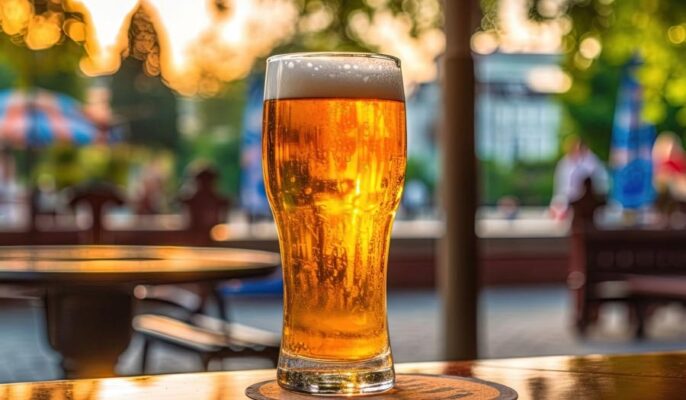Alcohol-free beer is a new product on the market and its popularity is growing . Alcohol-free beverages surprise and confuse many people, and some don’t understand the reasoning behind alcohol-free beer. Most non-alcoholic beers actually start out as regular alcoholic beers. This means it goes through almost the exact same process as regular beer, from making the mash, to boiling the wort, to adding hops, and even fermentation. The two then turned in different directions.
What is alcohol-free beer?
Despite its name, non-alcoholic beer is allowed to have an alcohol by volume content (ABV) of up to 0.5%. Trace amounts are allowed because the common method of brewing alcohol-free beer makes reaching absolute zero rather difficult. But, there are also true 0.0% ABV beers, known as non-alcoholic beers. Some versions of non-alcoholic beer are reminiscent of soda water and are the result of mixing water with things like non-alcoholic malt and hop syrup.

Alcohol-free beer ingredients
Like regular alcoholic beers, non-alcoholic beers are brewed with four standard ingredients: water, grains, hops and yeast. Water makes up the vast majority of all beer. The grains provide the sugar, which the yeast converts into alcohol through the fermentation process. Hops provide the familiar bitterness and aroma found in many beers. Breweries often add flavors and other ingredients to create alcohol-free beer recipes, but everything is made with these four basic ingredients.
Como é produzida a cerveja sem álcool?
Many common methods of producing alcohol-free beer rely on using expensive, specialized equipment to remove ethanol from the beer, but this method can only be used on a large scale. Not only is this process costly for craft brewers, but it also results in the removal of volatiles and other flavor compounds, affecting the quality of the beer. To address this challenge, small breweries are using novel biological methods to produce low-alcohol beers, rather than using filtration to remove alcohol from beer.
Alcohol-free beers are brewed using one of four main methods: controlled fermentation, dealcoholization, dilution, or simulated fermentation.
Dealcoholization
There are many methods of dealcoholization, many of which are new to the market. Larger breweries more use the dealcoholization method to produce alcohol-free beer because of the high cost of equipment. Dealcoholization processes can include heating and membrane-based processes such as vacuum distillation, membrane filtration and reverse osmosis.
Dilution
Dilution involves adding water to the finished leaded beer, reducing the alcohol content by diluting it with water.
The amount of water added depends on the alcohol content of the original beer, but is usually around 10%. This means that if your beer has an ABV (alcohol by volume) of 5%, diluting it with 10% water will reduce its ABV to 4%. This can be done before or after fermentation.
Fermentação controlada
The controlled fermentação process is a technology used to produce alcohol-free beer. It involves controlling the temperature and time the yeast is in contact with the sugar to prevent the production of alcohol during fermentation, by adding yeast to the sugar in a large tank, but in smaller amounts than in alcoholic beer. The purpose is to produce the unique foam and aroma of beer without producing alcohol. In alcohol-free brewing, the entire fermentation process proceeds right up to carbonation, and then the mixture is heated to remove the alcohol.
Simulated fermentation
In some cases, brewers wish to avoid sugar fermentation . Using a simulated fermentation approach, they skip the fermentation process when brewing and add ingredients and enzymes to simulate the same effect. It is used to ensure that there is not a drop of alcohol in the beer.

How to remove alcohol from traditional beer?
Osmose inversa
Reverse osmosis pushes beer through a semipermeable membrane at high pressure. The water is then separated from the alcohol by distillation and directed back into the beer using special dealcoholization equipment.
Ebulição
The most common method is to add water or steam to the liquid and boil it under pressure. The alcohol is then released in vapor form into the condenser where it is collected and discharged.
Destilação a vácuo
To ease this situation, some breweries switch to vacuum distillation. While the original boiling point of alcohol is about 173.1°F, the vacuum helps reduce it to 93.2°F. So, the beer is not heated to the point where it might lose flavor, but only to a warm temperature. This allows it to keep its flavor intact while still evaporating the alcohol from the mixture.
Benefits of alcohol-free beer
Craft brewers are taking alcohol-free beers to the next level, making them easy to incorporate into a full, active life. you’re meeting friends for lunch but have new plans ahead, so a non-alcoholic beer is recommended.
What does alcohol-free beer taste like?
Since non-alcoholic beer goes through the exact same process as traditional alcoholic beer, except that the alcohol is removed in the final stages of the process, you should end up with a beer that tastes very similar. Removing all the alcohol will change the flavor , but the flavor profile should be the same. If you’re trying to avoid drinking alcohol altogether for whatever reason, non-alcoholic beer is your best option.




